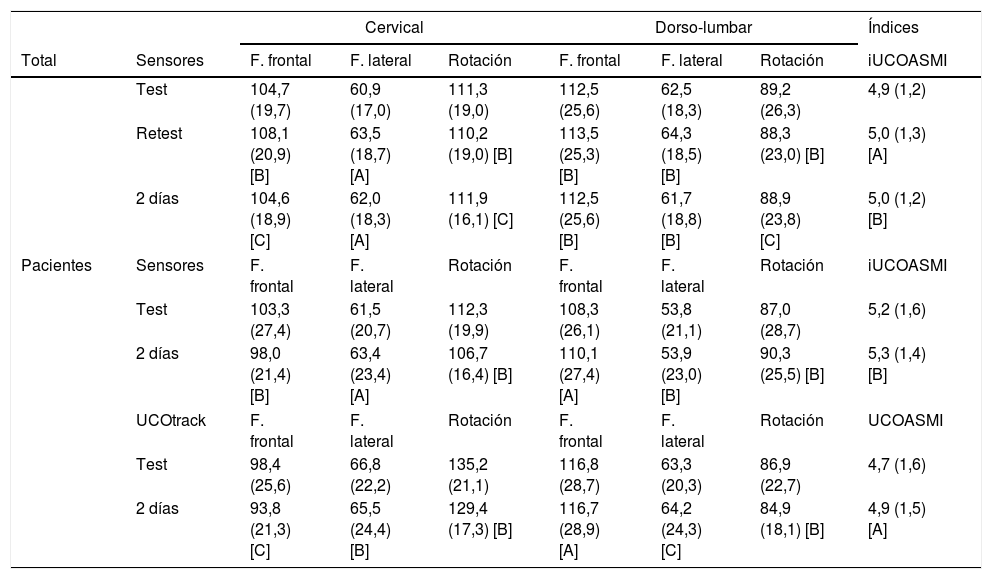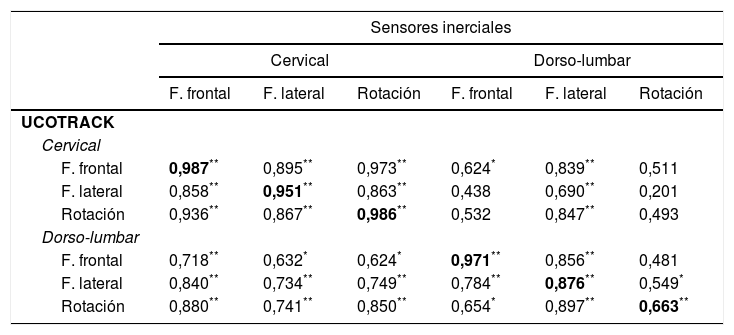La espondiloartritis axial (EspAx) es una enfermedad reumática que afecta a toda la columna del paciente (lumbar, dorsal y cervical) y produce una reducción de la movilidad a medida que la enfermedad avanza. Diversas herramientas metrológicas se han propuesto para evaluar esta movilidad. El objetivo de nuestro estudio es evaluar el uso de sensores inerciales (Inertial Measuring Unit) como herramienta para la medición de la movilidad espinal en pacientes con EspAx.
Material y métodoEstudio descriptivo y transversal donde se define la movilidad espinal por el movimiento cervical y dorsolumbar en los planos frontal, lateral y trasversal. Se utilizaron 7 pacientes con EspAx y 7 individuos sanos como grupo control. La movilidad se midió de forma sincronizada con un sistema basado en sensores inerciales y otro sistema de captura de movimiento basado en vídeo (UCOTrack©). Además, se obtuvieron medidas de metrología convencional. Finalmente se calcularon índices compuestos basados en estas medidas: BASMI, UCOASMI e iUCOASMI.
ResultadosTanto las medidas individuales como el índice obtenido a partir de los sensores, iUCOASMI, presentaron buena fiabilidad y concordancia con coeficientes de correlación intraclase superiores a 0,7 (¿0,95 en el grupo de pacientes) y excelente correlación (p<0,01) con UCOASMI y BASMI. En un ajuste de correlación lineal de iUCOASMI/UCOASMI se obtuvo una R2 de 0,97.
DiscusiónLos resultados obtenidos indican que los sensores inerciales podrían ser útiles para analizar la movilidad espinal en pacientes con EspAx de forma más precisa y fiable que la metrología convencional, y más flexible y económica que otros sistemas avanzados.
Axial Spondyloarthritis (AxSpa) is a rheumatic disease that affects the entire spine of the patient (lumbar, dorsal and cervical) and produces a reduction of mobility as the disease progresses. Several metrological tools have been proposed to assess this mobility. The objective of our study is to evaluate the use of inertial sensors “Inertial Measuring Unit” (IMU) as a tool for the measurement of spinal mobility in patients with AxSpA.
Material and methodDescriptive and transversal study where spinal mobility is defined by cervical and dorsal-lumbar movement in frontal, lateral and transverse planes; by means of non-probabilistic sampling, 7 patients with AxSpA and 7 healthy subjects were recruited as control group. Mobility was measured synchronously with a system based on inertial motion sensors (IMU) and another video-based motion capture system (UCOTrack©). In addition, measurements of conventional metrology. Finally the BASMI (Bath Ankylosing Spondylitis Metrology Index), UCOASMI (University of Cordoba Ankilosing Spondylitis Metrology Index) and iUCOASMI index were obtained.
ResultsBoth the individual measures obtained with the IMU and the composite index obtained from these measures, the iUCOASMI, show good reliability and concordance with intraclass correlation coefficients (ICC) above .7 (ICC¿.95 in the patient group), and an excellent correlation (P<.01) between iUCOASMI with UCOASMI and BASMI. In an adjustment of linear correlation of iUCOASMI/UCOASMI a R2 of .97 was obtained.
DiscussionResults obtained shown that inertial sensors could be useful for analyzing spinal mobility in patients with AxSpA in a more accurate and reliable way than conventional metrology, and more flexible and economical than other advanced systems.
Artículo
Comprando el artículo el PDF del mismo podrá ser descargado
Precio 19,34 €
Comprar ahora












